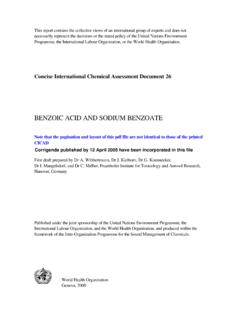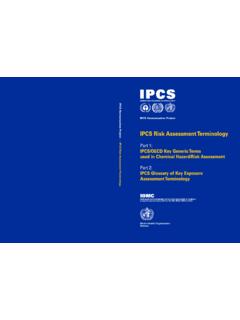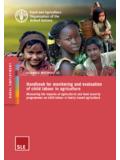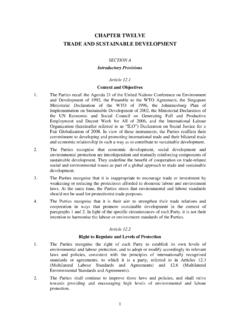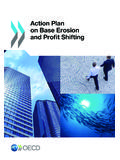Transcription of FORMALDEHYDE - who.int
1 This report contains the collective views of an international group of experts and does notnecessarily represent the decisions or the stated policy of the United Nations EnvironmentProgramme, the international labour organization , or the World Health international Chemical Assessment Document 40 FORMALDEHYDEP lease note that the layout and pagination of this pdf file are not necessarily identical tothose of the printed CICADF irst draft prepared Liteplo, R. Beauchamp, Meek, Health Canada, Ottawa, Canada, andR. Ch nier, Environment Canada, Ottawa, CanadaPublished under the joint sponsorship of the United Nations Environment programme , theInternational labour organization , and the World Health organization , and produced within theframework of the Inter- organization programme for the Sound Management of Health OrganizationGeneva, 2002 The international programme on Chemical Safety (IPCS), established in 1980, is a joint ventureof the United Nations Environment programme (UNEP), the international labour organization (ILO),and the World Health organization (WHO).
2 The overall objectives of the IPCS are to establish thescientific basis for assessment of the risk to human health and the environment from exposure tochemicals, through international peer review processes, as a prerequisite for the promotion of chemicalsafety, and to provide technical assistance in strengthening national capacities for the sound managementof Inter- organization programme for the Sound Management of Chemicals (IOMC) wasestablished in 1995 by UNEP, ILO, the Food and Agriculture organization of the United Nations, WHO,the United Nations Industrial Development organization , the United Nations Institute for Training andResearch, and the Organisation for Economic Co-operation and Development (ParticipatingOrganizations), following recommendations made by the 1992 UN Conference on Environment andDevelopment to strengthen cooperation and increase coordination in the field of chemical safety.
3 Thepurpose of the IOMC is to promote coordination of the policies and activities pursued by the ParticipatingOrganizations, jointly or separately, to achieve the sound management of chemicals in relation to humanhealth and the Library Cataloguing-in-Publication DataFormaldehyde.(Concise international chemical assessment document ; 40) - adverse effects assessment programme on Chemical Safety 92 4 153040 5 (NLM Classification: QV 225) ISSN 1020-6167 The World Health organization welcomes requests for permission to reproduce or translate itspublications, in part or in full. Applications and enquiries should be addressed to the Office of Publications,World Health organization , Geneva, Switzerland, which will be glad to provide the latest information onany changes made to the text, plans for new editions, and reprints and translations already available.
4 World Health organization 2002 Publications of the World Health organization enjoy copyright protection in accordance with theprovisions of Protocol 2 of the Universal Copyright Convention. All rights designations employed and the presentation of the material in this publication do not imply theexpression of any opinion whatsoever on the part of the Secretariat of the World Health Organizationconcerning the legal status of any country, territory, city, or area or of its authorities, or concerning thedelimitation of its frontiers or mention of specific companies or of certain manufacturers products does not imply that they areendorsed or recommended by the World Health organization in preference to others of a similar naturethat are not mentioned.
5 Errors and omissions excepted, the names of proprietary products aredistinguished by initial capital Federal Ministry for the Environment, Nature Conservation and Nuclear Safety, Germany,provided financial support for the printing of this by Wissenschaftliche Verlagsgesellschaft mbH, D-70009 Stuttgart 10iiiTABLE OF AND PHYSICAL/CHEMICAL OF HUMAN AND ENVIRONMENTAL and TRANSPORT, DISTRIBUTION, AND LEVELS AND HUMAN and and exposure: exposure: KINETICS AND METABOLISM IN LABORATORY ANIMALS ON LABORATORY MAMMALS AND IN VITRO TEST and medium-term 20 Concise international Chemical Assessment Document exposure and and related effects and of ON reports and clinical irritancy and ON OTHER ORGANISMS IN THE LABORATORY AND Evaluation of health 40 response 44 human health risk 45 in the evaluation of health Evaluation of environmental environmental risk of EVALUATIONS BY international 49 FormaldehydevAPPENDIX 1 SOURCE 61
6 APPENDIX 2 CICAD PEER 62 APPENDIX 3 CICAD FINAL REVIEW 63 APPENDIX 4 BIOLOGICALLY MOTIVATED CASE-SPECIFIC MODEL FOR 64 APPENDIX 5 ESTIMATION OF TUMORIGENIC CONCENTRATION05 (TC05).. 67 APPENDIX 6 ADDITIONAL INFORMATION ON ENVIRONMENTAL RISK CHARACTERIZATION. 67 international CHEMICAL SAFETY 69R SUM D 71 RESUMEN DE ORIENTACI 74 Formaldehyde1 FOREWORDC oncise international Chemical AssessmentDocuments (CICADs) are the latest in a family ofpublications from the international programme onChemical Safety (IPCS) a cooperative programme ofthe World Health organization (WHO), the InternationalLabour organization (ILO), and the United NationsEnvironment programme (UNEP).
7 CICADs join theEnvironmental Health Criteria documents (EHCs) asauthoritative documents on the risk assessment Chemical Safety Cards on therelevant chemical(s) are attached at the end of theCICAD, to provide the reader with concise informationon the protection of human health and on emergencyaction. They are produced in a separate peer-reviewedprocedure at IPCS. They may be complemented byinformation from IPCS Poison Information Monographs(PIM), similarly produced separately from the are concise documents that provide sum-maries of the relevant scientific information concerningthe potential effects of chemicals upon human healthand/or the environment.
8 They are based on selectednational or regional evaluation documents or on existingEHCs. Before acceptance for publication as CICADs byIPCS, these documents undergo extensive peer reviewby internationally selected experts to ensure theircompleteness, accuracy in the way in which the originaldata are represented, and the validity of the primary objective of CICADs is characteri-zation of hazard and dose response from exposure to achemical. CICADs are not a summary of all available dataon a particular chemical; rather, they include only thatinformation considered critical for characterization of therisk posed by the chemical. The critical studies are,however, presented in sufficient detail to support theconclusions drawn.
9 For additional information, thereader should consult the identified source documentsupon which the CICAD has been to human health and the environment willvary considerably depending upon the type and extentof exposure. Responsible authorities are stronglyencouraged to characterize risk on the basis of locallymeasured or predicted exposure scenarios. To assist thereader, examples of exposure estimation and riskcharacterization are provided in CICADs, wheneverpossible. These examples cannot be considered asrepresenting all possible exposure situations, but areprovided as guidance only. The reader is referred to EHC1701 for advice on the derivation of health-basedguidance every effort is made to ensure that CICAD srepresent the current status of knowledge, new informa-tion is being developed constantly.
10 Unless otherwisestated, CICADs are based on a search of the scientificliterature to the date shown in the executive summary. Inthe event that a reader becomes aware of new informa-tion that would change the conclusions drawn in aCICAD, the reader is requested to contact IPCS to informit of the new flow chart on page 2 shows the proceduresfollowed to produce a CICAD. These procedures aredesigned to take advantage of the expertise that existsaround the world expertise that is required to producethe high-quality evaluations of toxicological, exposure,and other data that are necessary for assessing risks tohuman health and/or the environment. The IPCS RiskAssessment Steering Group advises the Co-ordinator,IPCS, on the selection of chemicals for an IPCS riskassessment, the appropriate form of the document ( ,EHC or CICAD), and which institution bears theresponsibility of the document production, as well as onthe type and extent of the international peer first draft is based on an existing national,regional, or international review.










